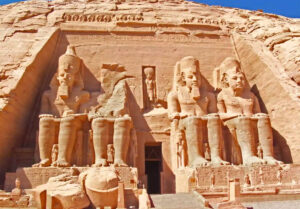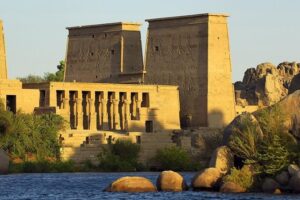A Coptic Christian sites tour in Egypt primarily focuses on the rich history and enduring legacy of one of the world’s oldest Christian communities. The main concentration of these sites is in Coptic Cairo, an ancient area within Old Cairo, but significant monasteries and churches are also found in other regions.
Here are the key details about Coptic Christian sites tours in Egypt:
Key Sites and Their Significance
In Coptic Cairo (Old Cairo): This picturesque enclave, surrounded by walls dating back to a 3rd-century Roman fortress, is home to a cluster of important Christian and Jewish landmarks.
The Hanging Church (Saint Virgin Mary’s Coptic Orthodox Church):
-
- Description: One of the most iconic landmarks, named for its elevated position built atop the gatehouse of the Roman-era Babylon Fortress. Its roof is uniquely shaped like Noah’s Ark.
- History: Dates back to the 3rd century and served as the residence for the Coptic Patriarch from the 7th to the 13th centuries.
- Features: Intricate wooden screens, marble pulpit, flickering candles before icons, and beautiful Coptic frescoes depicting saints and biblical figures.
Saints Sergius and Bacchus Church (Abu Serga):
-
-
- Description: A 4th-century church believed to be built over a cave where the Holy Family (Mary, Jesus, and Joseph) rested during their flight into Egypt to escape King Herod.
- Significance: Considered a significant pilgrimage site for Copts and a symbol of enduring Christian faith. It has deep historical importance, with many Coptic patriarchs elected here.
- Features: Sacred chambers, ancient frescoes, and a crypt where the faithful drop written prayers, known as a healing shrine.
-
Ben Ezra Synagogue:
-
- Description: Although Jewish, this synagogue is often included in Coptic Cairo tours due to its historical proximity and shared heritage. Tradition states it’s built on the site where baby Moses was found.
- History: Dates back to the 9th century and was a significant place of worship for North African Jews for centuries. It was a place of pilgrimage for North African Jews for many centuries, and was restored in the 12th century by Abraham Ben Ezra.
- Significance: A testament to the intertwining histories of the Abrahamic faiths in Egypt.
Coptic Museum:
-
- Description: Houses one of the world’s most extensive collections of Coptic Christian artifacts, spanning over a millennium of Egyptian history.
- Exhibits: Frescoes, ivory carvings, metalwork, textiles, icons, manuscripts, pottery, ancient books, and various other artifacts that illustrate how Christianity influenced ancient Egyptian culture.
- Architecture: The museum building itself features notable wooden ceilings, Mashrabeya screens and windows, and a pleasant garden.
Church of St. Barbara:
-
- Description: Another beautiful church in Coptic Cairo, known for its historical and religious significance, named after a Coptic martyr from the 3rd century AD.
- Features: Wonderful icons and a finely ornamented wooden sanctuary screen with inlaid ivory.
Church of Saint George (Mar Girgis):
-
- Description: An impressive round-shaped church, constructed in the 20th century in accordance with the nearby Babylon Fort.
Virgin Mary Church:
-
- Description: The oldest Coptic church in Haret Zuweila, dates back to the 10th century. It served as the seat of the Orthodox Pope of Alexandria from 1400 AD to 1520 AD.
Beyond Coptic Cairo:
The Cave Church of Saint Simon (St. Samaan the Tanner Monastery):
-
- Location: Located in the Mokattam Mountain in southeastern Cairo, in an area known as “Garbage City.”
- Description: One of the largest churches in Egypt, with seven cave churches carved into the mountain and an amphitheater with a seating capacity of 20,000. It is a major gathering place for Christians.
Monasteries of Saint Anthony and Saint Paul:
-
- Location: In the Red Sea region, near El Sokhna.
- Description: Considered the oldest Christian monasteries, both dating back to the 4th century AD. They are among the holiest sites of the Coptic Church in Egypt.
Monasteries of Wadi El-Natrun:
-
- Description: Another significant area for Coptic monasteries, offering a glimpse into ancient monastic life.
Tour Details and Considerations
Duration: Most Coptic Cairo tours are typically day tours, lasting anywhere from 4 to 8 hours. Tours to monasteries outside Cairo may be full-day excursions (e.g., 10 hours for St. Anthony and St. Paul).
Inclusions: Tours often include:
- Professional tour guide (often an Egyptologist).
- All transfers in a modern, air-conditioned vehicle.
- Hotel pick-up and drop-off in Cairo/Giza.
- Entrance fees to mentioned sites.
- Lunch at a local restaurant.
- Bottled water.
- All services, charges, and taxes.
Tour Type: Many tours are private, offering personalized attention. Group tours may also be available.
Cost: Prices vary widely depending on the tour operator, inclusions, and whether it’s a private or group tour. Examples found range from approximately US150 per person for day tours within Cairo.
Itinerary: A typical Coptic Cairo day tour often begins with hotel pick-up, followed by visits to the Hanging Church, Ben Ezra Synagogue, Abu Serga Church, and potentially the Coptic Museum or other churches. Some tours might extend to include the Cave Church of Saint Simon.
Historical Context on Coptic Christian sites tour: Guides often explain the history of Christianity in Egypt, the Coptic Orthodox Church, and the significance of each site, providing insights into the early days of Christianity, the persecution of early Christians, and their enduring influence on Egypt’s culture.
These tours offer a unique opportunity to explore the spiritual and cultural heritage of Coptic Christianity in Egypt, witnessing ancient architecture, religious artifacts, and places of profound historical importance.
Before you go, do not forget to check Egypt’s weather.
Contact us to book your Coptic Christian sites Tour











